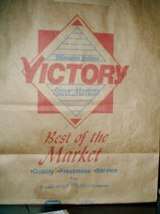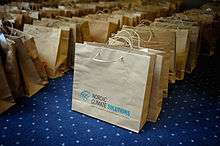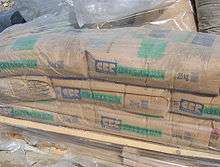Paper bag
A paper bag is a bag made of paper, usually kraft paper. Paper bags are commonly used as shopping bags, packaging, and sacks.


History
In 1852, Francis Wolle, a schoolteacher, invented the first machine to mass-produce paper bags.[1] Wolle and his brother patented the machine and founded the Union Paper Bag Company.
In 1871, inventor Margaret E. Knight designed a machine that could create flat-bottomed paper bags, which could carry more than the previous envelope-style design.
In 1883, Charles Stilwell patented a machine that made square-bottom paper bags with pleated sides, making them easier to fold and store.[2] This style of bag came to be known as the S.O.S., or "Self-Opening Sack".[3]
In 1912, Walter Deubener, a grocer in Saint Paul, Minnesota, used cord to reinforce paper bags and add carrying handles. These "Deubener Shopping Bags" could carry up to 75 pounds at a time, and became quite popular, selling over a million bags a year by 1915. Paper bags with handles later became the standard for department stores, and were often printed with the store's logo or brand colors.
Plastic bags were introduced in the 1970s, and thanks to their lower cost, eventually replaced paper bags as the bag of choice for grocery stores.[4] With the trend towards phasing out lightweight plastic bags, though, some grocers and shoppers have switched back to paper bags.[5]
In 2015, the world's largest paper shopping bag was made in the UK and recorded by Guinness World Records.[6]
Production
Standard brown paper bags are made from kraft paper. Tote-style paper bags, such as those often used by department stores or as gift bags, can be made from any kind of paper, and come in any color. Paper bags can be made from recycled paper, with some local laws requiring bags to have a minimum percentage of post-consumer recycled content.[7]
Single layer

Paper shopping bags, brown paper bags, grocery bags, paper bread bags and other light duty bags have a single layer of paper. A variety of constructions and designs are available. Many are printed with the names of stores and brands. Paper bags are not waterproof. Types of paper bag are: laminated, twisted, flat tap. The laminated bag, whilst not totally waterproof, has a laminate that protects the outside to some degree.[8]
Multiwall paper sacks


Multiwall (or multi-wall) paper sacks or shipping sacks are often used as shipping containers for bulk materials such as fertilizer, animal feed, sand, dry chemicals, flour and cement. Many have several layers of sack papers, printed external layer and inner plies.[9] Some paper sacks have a plastic film, foil, or polyethylene coated paper layer in between as a water-repellant, insect resistant, or rodent barrier.
There are two basic designs of bags: open mouth bags and valve bags. An open mouth bag is a tube of paper plies with the bottom end sealed. The bag is filled through the open mouth and then closed by stitching, adhesive, or tape. Valve sacks have both ends closed and are filled through a valve. A typical example of a valve bag is the cement sack.
Recycling
Paper bags are readily recyclable. Plastic or water-resistant coatings or layers make recycling more difficult.[10] Paper bag recycling is done through the re-pulping of the paper recycling and pressing into the required shapes.
Brown bag
While brown is the color of the most common type of paper bag, this pair of words connotes more than just the color.
The verb form of brown bag, depending on content, may be an act of civil disobedience (and illegal)[11] or an action by "60 million American brown baggers" whom a marketing research study's review by the New York Times described as "upscale."[12]
The former refers to lack of a liquor license, whereas the latter are for "particularly those on vegetarian, low-salt, low-cholesterol or kosher diets."
The noun form of the term included in the Merriam-Webster dictionary in 1950 refers to use of a paper bag instead of a lunch box. William Safire traces this to an article in Time magazine.
When the content is solid food, it may be preserved or enhanced before being consumed because "a substantial minority of brown baggers have access to microwave ovens or refrigerators."[12]
Anti-brown-bag law
The words "Brown-bagging is the genteel disguise ... by a patron to furnish his own liquor when he dines at the local restaurant" were published in 1967.[11]
To prevent individuals (or groups) from bringing alcoholic beverages into food establishments that lack a liquor license, in 1985 the New York State Liquor Authority pushed for legislation that New York City's Mayor Ed Koch denounced, months after being "arrested" for this.[13] The New York Times noted that some call the bill "the anti-brown-bag law."[11]
Brown Bag Report
The advertising agent who, prior to the Marlboro Man, [12] developed ads for the product as a filtered "feminine brand"[14][15]:p.LB-6 in 1981 developed "The Brown-Bag Report" with funding from Swift, Carnation, General Mills and American Can.
Symbolism
While in the United States the lunch box or lunch pail has been used as a symbol of the working class, Safire wrote: "In the metaphor of the modern worker, the brown bag has replaced the lunch pail."[11]
About a third of the brown baggers are schoolchildren.[12]
References
- "Patent US9355". Retrieved March 6, 2013.
- "Charles Stilwell". Ohio History Central. Retrieved 2015-06-10.
- MoMA | Margaret E. Knight and Charles B. Stilwell. Flat-Bottomed Paper Bag. 1870s-1880s
- Ball, Jeffrey (2009-06-12). "Paper or Plastic? A New Look at the Bag Scourge". The Wall Street Journal. Retrieved 2015-06-11.
- Pereira, Andrew (2015-06-09). "Oahu's bag ban includes exemptions and substitutes". KITV.com. Archived from the original on June 13, 2015. Retrieved 2015-06-11.
- "largest shopping bag made from paper". Guinness World Records.
- "California - Bag Legislation". BagLaws.com. 2014-09-30. Retrieved 2015-06-11.
- "Kenya Bureau of Standards (KEBS) : Paper bags – specification" (PDF).
- Paulapuro, Hannu (2000). "5". Paper and Board grades. Papermaking Science and Technology. 18. Finland: Fapet Oy. pp. 121–122. ISBN 978-952-5216-18-9.
- R. McKinney: Technology of Paper Recycling, 1995, p. 351. ISBN 9780751400175
- William Safire (September 16, 1985). "On Language: Arcane Brown Bag". The New York Times.
- Samuel G. Freedman (January 5, 1983). "The flavor of the Brown-Bag way of life". The New York Times.
- Sydney H. Schanberg (March 20, 1984). "Bagging the brown bag mob". The New York Times.
- "Leo Burnett, still reaching for the stars after 60 years". Advertising Age. July 31, 1995.
- "Burnett repositioned Marlboro cigarettes from a feminine brand to one that shouted masculinity"
Further reading
- Yam, K. L., "Encyclopedia of Packaging Technology", John Wiley & Sons, 2009, ISBN 978-0-470-08704-6 doi:10.1002/9780470541395
External links

- See more Paper bag Vietnamese Version
- Paper Bag Day